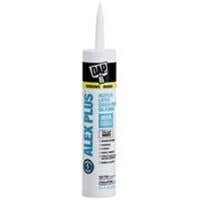Caulk Explained
 You probably have heard about caulking. “Caulk” and “Sealant” are interchangeable terms. A caulk/sealant is a material one would use to fill and seal a joint or gap (wherever joints can move or leak). Examples include caulking around windows, doors, crown and baseboard moldings, bathtubs and sinks. Any great house painter will tell you that caulking often makes the difference between a great paint job and an OK one.
You probably have heard about caulking. “Caulk” and “Sealant” are interchangeable terms. A caulk/sealant is a material one would use to fill and seal a joint or gap (wherever joints can move or leak). Examples include caulking around windows, doors, crown and baseboard moldings, bathtubs and sinks. Any great house painter will tell you that caulking often makes the difference between a great paint job and an OK one.
Caulking is important for many reasons. It is used to repair joints and gaps and provide a weatherproof seal. This helps save energy by reducing heating and air conditioning bills, as well as providing a more comfortable "draft-free" living space. Different materials contract and expand with varying temperatures. Caulking materials remain flexible and maintain the seal between the two surfaces. Caulks also provide a barrier against moisture and water to prevent cracking and rotting from occurring in the wood, and closes gaps to insects and other unwanted visitors from entering your home. And finally, caulking creates an attractive gap-free finish in corners, joints and other gaps that occur anytime different building material come together.
There are many different types of caulk so it is important to find the right one for the job. The good news is that there are typically only a few that are used for house painting and repairing certain areas. The ones used for this purpose are latex caulk, 100% silicone caulk and specialty caulks.
Latex caulk
Latex caulk is the most commonly used type of caulk for painting projects. It is used for sealing around your windows, doors and trim. It is paintable and comes in a few common colors like white, almond and brown. It cleans up with soap and water and applies easily. Some types contain some silicone which makes it a bit more durable but also remains paintable.
There are 3 basic types of latex caulks – standard, siliconized and elastomeric. All latex caulks are water clean up, easily paintable, and have only a slight odor. Because they clean up with water, latex caulks must be applied when there is no rain or freezing temperatures forecast for several days – or it would wash away the caulk (clear latex caulks are technically paintable, but we recommended use white if you plan on painting it).
- Standard latex caulks are inexpensive, have minimal flexibility, and shorter life expectancies than most other caulks.
- Siliconized latex caulks have increased flexibility and adhesion, and are more durable than a standard latex.
- The elastomeric sealants are the best latex technology available. They have the performance of a silicone, but still clean up with water and are paintable. Elastomeric caulk is used to fill extraordinarily large gaps. It is very flexible and can expand and contract to fill these areas. It is most commonly used outside where the surfaces and gaps are subject to large temperature variations, expansions and contractions.
There are also specialized versions of latex caulks for specific tasks. As an example, you should use kitchen and bath caulk for kitchen and bath areas because they have extra mildew and water resistance.
100% Silicone Caulks and Sealants
Silicone caulks are completely waterproof and are the best choice for sealing non-porous surfaces such as ceramic tile, glass and metal surfaces. However, silicones do not adhere to non-porous surfaces such as concrete as well as a latex based caulk. They have strong adhesive properties and work well for a variety of purposes and have much greater resistance to water than latex caulks. Silicones are not paintable and clean up with a solvent.
Specialty caulks
Butyl rubber based, asphalt based and polyurethane based sealers are used for more specific applications. Butyl rubber sealants are highly resistant to moisture, and work well for roofing and gutter applications. Asphalt products are used for sealing asphalt shingles or pavement, and the concrete sealants are used for concrete driveways and patios, concrete block wall, etc. Polyurethane sealants are extremely durable and generally are the most flexible sealants available, but they are messy to apply and difficult to work with. Solvent based products contain higher levels of VOCs (Volatile Organic Compounds) than water based products and are flammable. They have a stronger solvent odor and require ventilation during application and curing time.
Caulk Application
You can apply caulk with the traditional caulking gun but if you only have one or two things to caulk and you aren't going to use a caulking gun regularly, you might find that a squeeze tube or pressurized can with an extended narrow tip would be better for your use.
Applying caulk is very easy but you might want to practice a couple of lines to get the hang of it. Also apply it sparingly; most problems with caulk occur because too much is applied. Before you use caulk on a surface it is a good idea to clean it and let it dry.
